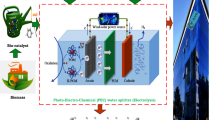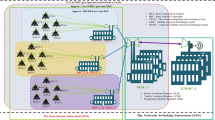Abstract
In this paper, a new multi-generation system is proposed and analyzed through energy and exergy. The new system uses solar power as its energy source and delivers six beneficial productions for the residential sector, such as hotels. These outputs include hot water, electricity, heating, cooling, dry air, and hydrogen production. The effects of some factors such as the inlet and outlet temperature of turbine and ambient temperature on the performances of the system are evaluated. The results show that the energetic COP of the absorption chiller cycle is found to be 60%, whereas the exergetic COP of the absorption system is found to be about 10%. Also, energetic and exergetic efficiency of the organic Rankine cycle is determined to be 8 and 27%, respectively. Moreover, overall energetic and exergetic efficiency of the system is found to be 70 and 53%, respectively.







Similar content being viewed by others
Abbreviations
- \(\dot{EX}\) :
-
Exergy rate (kW)
- Ex:
-
Specific exergy (kJ/kg)
- h :
-
Specific enthalpy (kJ/kg)
- \(\dot{m}\) :
-
Mass flow rate (kg/s)
- P :
-
Pressure (kPa)
- Tb:
-
Turbine
- EG:
-
Electricity generator
- S :
-
Specific entropy (kJ/kg-K)
- t :
-
Temperature (K)
- V :
-
Specific volume (m3/kg)
- abs:
-
Absorber
- Evap:
-
Evaporator
- EV:
-
Expansion valve
- TV:
-
Throttle valve
- SG:
-
Steam generator
- El:
-
Electrolyzer
- LiBr:
-
Lithium bromide
- 1, 2,…,32:
-
State numbers
- d :
-
Destruction
- G :
-
Generator
- P i :
-
Pump i
- P ii :
-
Pump ii
- C i :
-
Condenser i
- C ii :
-
Condenser ii
- HEX i:
-
Heat exchanger i
- HEX ii:
-
Heat exchanger ii
- \(\eta\) :
-
Energy efficiency
- Ψ:
-
Exergy efficiency
References
Ahmadi P, Dincer I, Rosen MA (2013a) Development and assessment of an integrated biomass-based multi-generation energy system. Energy 1(56):155–166
Ahmadi P, Dincer I, Rosen MA (2013b) Performance assessment and optimization of a novel integrated multigeneration system for residential buildings. Energy Build 31(67):568–578
Al-Sulaiman FA, Hamdullahpur F, Dincer I (2012) Performance assessment of a novel system using parabolic trough solar collectors for combined cooling, heating, and power production. Renew Energy 48:161–172
Atikol U, Abbasoglu S, Nowzari R (2013) A feasibility integrated approach in the promotion of solar house design. Int J Energy Res 37(5):378–388
Bicer Yusuf, Dincer Ibrahim (2015) Development of a multigeneration system with underground coal gasification integrated to bitumen extraction applications for oil sands. Energy Convers Manag 106:235–248
Dincer I, Rosen MA (2012) Exergy: energy, environment and sustainable development. Newnes, Oxford
Islam S, Dincer I, Yilbas BS (2015) Energetic and exergetic performance analyses of a solar energy-based integrated system for multigeneration including thermoelectric generators. Energy 93:1246–1258
Kaviri AG, Jafar MM, Tholudin ML, Sharifishourabi G (2013) Modelling and exergoeconomic based design optimisation of combined power plants. Int J Exergy 13(2):141–158
Khalid Farrukh, Dincer Ibrahim, Rosen Marc A (2015) Energy and exergy analyses of a solar-biomass integrated cycle for multigeneration. Sol Energy 112:290–299
Ozlu Sinan, Dincer Ibrahim (2015) Development and analysis of a solar and wind energy based multigeneration system. Sol Energy 122:1279–1295
Ozturk M (2012) Thermodynamics assessment of the multi-generation energy production systems. INTECH Open Access Publisher, Rijeka
Ozturk Murat, Dincer Ibrahim (2013) Thermodynamic analysis of a solar-based multi-generation system with hydrogen production. Appl Therm Eng 51(1):1235–1244
Ratlamwala TA, Dincer I (2013) Performance assessment of solar-based integrated Cu–Cl systems for hydrogen production. Sol Energy 30(95):345–356
Suleman F, Dincer I, Agelin-Chaab M (2014) Development of an integrated renewable energy system for multigeneration. Energy 78:196–204
Author information
Authors and Affiliations
Corresponding author
Rights and permissions
About this article
Cite this article
Sharifishourabi, M., Ratlamwala, T.A.H., Alimoradiyan, H. et al. Performance Assessment of a Multi-Generation System Based on Organic Rankine Cycle. Iran J Sci Technol Trans Mech Eng 41, 225–232 (2017). https://doi.org/10.1007/s40997-016-0057-x
Received:
Accepted:
Published:
Issue Date:
DOI: https://doi.org/10.1007/s40997-016-0057-x




